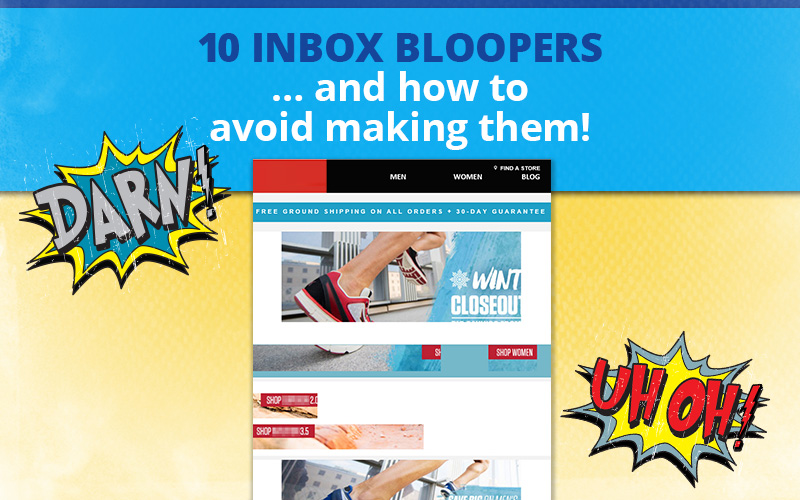Nobody is perfect — especially in the fast-paced niche of email marketing. Often, we’re expected to get an email out the proverbial door within hours. This environment can be a breeding ground for mistakes — some minor and some that can cost your company money or seriously damage your brand’s reputation.
Let’s take a look at 10 common mistakes that happen in email marketing. I’ll also share some strategies and tools you can use to avoid making these same mistakes. Here we go!
1. Laying Off the Proofreader
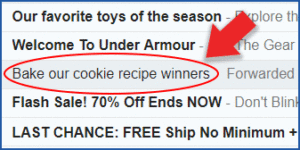 Typos, misspellings and grammar errors are far too commonplace in email. Even email copy that receives the most exposure — the subject line — is not immune to mistakes. Mistakes cost your brand credibility, so it’s always a good idea to have someone proof your email before you click “Send.” A trained proofreader can prevent mistakes that go unnoticed by both spellcheck programs and the person who wrote or built the email. If you’re a one-person marketing department and you can’t afford to contract a proofreader, then try these proofing strategies:
Typos, misspellings and grammar errors are far too commonplace in email. Even email copy that receives the most exposure — the subject line — is not immune to mistakes. Mistakes cost your brand credibility, so it’s always a good idea to have someone proof your email before you click “Send.” A trained proofreader can prevent mistakes that go unnoticed by both spellcheck programs and the person who wrote or built the email. If you’re a one-person marketing department and you can’t afford to contract a proofreader, then try these proofing strategies:
- Read the email in a different format. If you’ve written and edited it on a screen, then print the email out to proofread it.
- Read the email backwards to spot spelling errors.
- Read the email slowly and out loud.
- Take a break from the email for at least 15 minutes before proofing it.
2. Hanging On to Those You’ve Lost
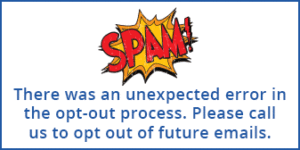 From a subscriber’s standpoint, there’s nothing worse than wanting to unsubscribe from a list and not being able to because the link to unsubscribe is hidden or the unsubscribe form is broken. Even worse, companies that have faulty unsubscribe forms could be hit with fines. That’s why brands need to be sure to test unsubscribe forms on a regular basis. When subscribers are ready to leave your email list, let them go gracefully. If you make unsubscribing difficult, your email will likely get flagged as spam. And too many spam complaints can hurt your ability to get messages delivered to the inbox instead of a junk folder.
From a subscriber’s standpoint, there’s nothing worse than wanting to unsubscribe from a list and not being able to because the link to unsubscribe is hidden or the unsubscribe form is broken. Even worse, companies that have faulty unsubscribe forms could be hit with fines. That’s why brands need to be sure to test unsubscribe forms on a regular basis. When subscribers are ready to leave your email list, let them go gracefully. If you make unsubscribing difficult, your email will likely get flagged as spam. And too many spam complaints can hurt your ability to get messages delivered to the inbox instead of a junk folder.
3. Tacky and Noncompliant Email Forms
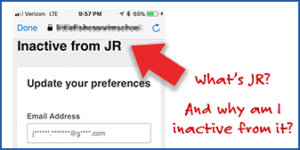 While we’re on the subject of forms, we also need to address email sign-up and preference center forms. If you are using MailChimp, be very careful how you name your lists. List names appear publicly on email preference center forms, so don’t label them names like “Cheap People Who Never Buy Anything.” Also, several new laws regulate how marketers collect permission to send email, and other countries are stricter than we are about opt-in requirements. Be sure your forms are compliant with express consent. Learn more about spam and privacy laws in Canada and the European Union.
While we’re on the subject of forms, we also need to address email sign-up and preference center forms. If you are using MailChimp, be very careful how you name your lists. List names appear publicly on email preference center forms, so don’t label them names like “Cheap People Who Never Buy Anything.” Also, several new laws regulate how marketers collect permission to send email, and other countries are stricter than we are about opt-in requirements. Be sure your forms are compliant with express consent. Learn more about spam and privacy laws in Canada and the European Union.
4. Crummy “From” Names and Email Addresses
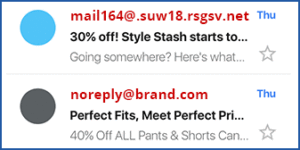 Email is a relationship-building medium, so sending email from does not make your subscribers feel valued. Rather, you should send marketing email from an address that is monitored, even if it’s by the customer service team. Also, consider using a friendly from name, and test it to see if you can drive higher open rates with different from names. Make sure DKIM and SPF records are set up on your domain so that you don’t have an “on behalf of” message associated with your from name.
Email is a relationship-building medium, so sending email from does not make your subscribers feel valued. Rather, you should send marketing email from an address that is monitored, even if it’s by the customer service team. Also, consider using a friendly from name, and test it to see if you can drive higher open rates with different from names. Make sure DKIM and SPF records are set up on your domain so that you don’t have an “on behalf of” message associated with your from name.
5. Email That Looks Junky in Some Inboxes
 Coding email is a complicated art form because different email inboxes render identical HTML code differently. That’s why it’s so important to send tests of your email to as many different inboxes as you can. Outlook and Gmail are notorious email rendering offenders, so definitely check your test emails in those email inboxes. Make sure calls to action are visible, no graphics are missing, and type is readable on desktops, tablets and phone screens.
Coding email is a complicated art form because different email inboxes render identical HTML code differently. That’s why it’s so important to send tests of your email to as many different inboxes as you can. Outlook and Gmail are notorious email rendering offenders, so definitely check your test emails in those email inboxes. Make sure calls to action are visible, no graphics are missing, and type is readable on desktops, tablets and phone screens.
6. Setting It and Forgetting It
 Part of the allure of automated, triggered emails is that you create them once. Then they send on demand from the time you turn them on until you turn them off. Just like Ron Popeil’s as-seen-on-TV rotisserie ovens, with email automations you truly can “set it and forget it.” Except there comes a point where email automations age past their shelf life. If you keep them running too long without reviewing and updating, you run the risk of sending subscribers the same message multiple times, sending outdated information or sending broken emails due to changes in the technology that powers your triggers. When this happens, your automated email does more harm than good. Here are some tips for avoiding automation mistakes.
Part of the allure of automated, triggered emails is that you create them once. Then they send on demand from the time you turn them on until you turn them off. Just like Ron Popeil’s as-seen-on-TV rotisserie ovens, with email automations you truly can “set it and forget it.” Except there comes a point where email automations age past their shelf life. If you keep them running too long without reviewing and updating, you run the risk of sending subscribers the same message multiple times, sending outdated information or sending broken emails due to changes in the technology that powers your triggers. When this happens, your automated email does more harm than good. Here are some tips for avoiding automation mistakes.
7. Being Impersonal
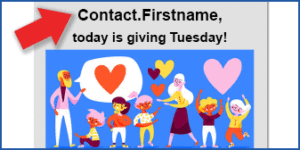 Email marketers often have a variety of personal information about their subscribers, from first and last name to birthday, address and purchase history. And we often fail to use it or forget to apply a fall-back option to use if that data doesn’t exist for a particular subscriber. If you’re personalizing by name, don’t forget to set up a default name. Receiving an email that kicks off with “Dear ,” doesn’t make a subscriber feel valued. If setting up a default name isn’t an option for you, using opening words like “Hey” and “Hello” can work.
Email marketers often have a variety of personal information about their subscribers, from first and last name to birthday, address and purchase history. And we often fail to use it or forget to apply a fall-back option to use if that data doesn’t exist for a particular subscriber. If you’re personalizing by name, don’t forget to set up a default name. Receiving an email that kicks off with “Dear ,” doesn’t make a subscriber feel valued. If setting up a default name isn’t an option for you, using opening words like “Hey” and “Hello” can work.
8. Neglecting the Preheader
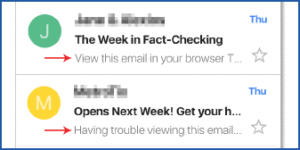 Be mindful of preheader copy, or your subscribers could see some pretty garbled things in their inbox. They might see “Having trouble reading this email?” Or perhaps the alt tags of your email header graphic and navigation, or even the code wrapped around the first image in your layout. Nothing says hello quite like “<a href=”http://www.brandname.com target=”_blank”><img src=http://assets…” Learn more about preheaders and get some tips for writing a great one.
Be mindful of preheader copy, or your subscribers could see some pretty garbled things in their inbox. They might see “Having trouble reading this email?” Or perhaps the alt tags of your email header graphic and navigation, or even the code wrapped around the first image in your layout. Nothing says hello quite like “<a href=”http://www.brandname.com target=”_blank”><img src=http://assets…” Learn more about preheaders and get some tips for writing a great one.
9. Using a Misleading Subject Line
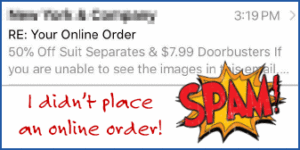 Here’s another mistake that your company can be fined for under the CAN-SPAM law. Subject lines should give subscribers an idea of what’s enclosed. Using a subject line like “RE: Your online order” for a sales email is not OK if no order has been placed. Subscribers do not like to feel duped, and this type of bait-and-switch subject line will cost your brand credibility.
Here’s another mistake that your company can be fined for under the CAN-SPAM law. Subject lines should give subscribers an idea of what’s enclosed. Using a subject line like “RE: Your online order” for a sales email is not OK if no order has been placed. Subscribers do not like to feel duped, and this type of bait-and-switch subject line will cost your brand credibility.
10. Sending Unintended Content
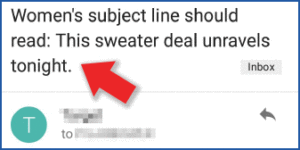 With a slip of a keystroke or a careless copy and paste, it’s easy to apply unintended content to an email. Just check out what the Utah State Bar Association sent out. Big oops! This is why you should always send tests after every change made to an email and before launching it.
With a slip of a keystroke or a careless copy and paste, it’s easy to apply unintended content to an email. Just check out what the Utah State Bar Association sent out. Big oops! This is why you should always send tests after every change made to an email and before launching it.
Need help reducing email errors? We can work with you to create a pre-launch email checklist that’s unique to your email program. Drop us a line at , or call 314-918-8088, ext. 101.

